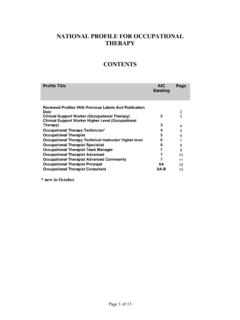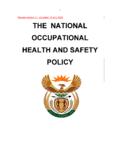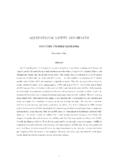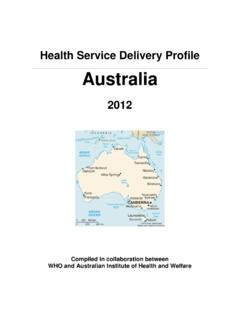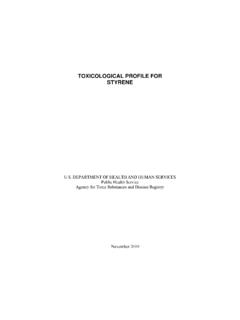Transcription of Situational Analysis of the Private Security Industry …
1 Situational Analysis of the Private Security Industry and national occupational Standards for Security Guards, Private Investigators and Armoured Car Guards. Prepared for: Police Sector Council Prepared by: Axel Hovbrender, , BGS, Eitzen & Associates Consulting Ltd. This is currently a discussion document designed to solicit additional input and information from registrars and Industry representatives. Input has been provided on an on-going basis to the project manager by both and the document is reflective of this input. On January 26th it was discussed by Provincial registrars of the Industry . Following that meeting changes were incorporated. The major change was a decision to separate the Armoured Car Guard NOS from this document and this job function may be subject to another inquiry at a later date. It was believed that there was a more fulsome discussion about this job classification needed with Provincial Firearm Officers and the Industry in relation to a number of issues.
2 This discussion document is now being sent to specific Industry representatives, who form an advisory council, who will be given the opportunity to review and comment on the document. Consideration will be given to the various inputs and weighed against the objective principles of Human Resource and Social Development (HRSD) Sector Council Situational Analysis and national occupational standard criteria. Subsequent to this process a final document will be prepared for consideration and approval by the steering committee of this initiative. Project Scope and Background The Police Sector Council (PSC), an established sector council, is working in partnership with Provincial Registrars of the Private Security Industry to develop a Situational Analysis of the Private Security Industry within Canada and to develop national occupational Standards (NOS) for three job functions within the Industry : 1. Security Guard 2. Private Investigator 3.
3 Armoured Car Guard Provinces/Territories are responsible for the regulation of Private Security businesses and individuals employed by them. As such, there are a number of different models of regulation; differing on the basis of specific legislation and regulatory philosophy. In the concept paper sponsored by the Police Sector Council to Human Resources and Social Development Canada (HRSDC), there was articulated a belief that there was a lack of consistency in the definition or regulation of Private Security roles across Canada. Jobs were defined differently and not all jurisdictions had conducted a jobs Analysis and defined task and competencies framework. The Agreement on Internal Trade (AIT) is one of the drivers in developing national standards for Private Security occupations. The AIT was signed in 1994 and it is designed to remove barriers to the movement of persons, goods, services and investments within Canada. Article 701 specifically calls for any worker qualified for an occupation in one province/territory to be granted access to employment opportunities in that occupation in any other province/territory.
4 Article 702 calls for the reduction of barriers to labour mobility related to occupational standards, licencing, certification, registration and residency requirements. Recently there has been discussion between Federal and Provincial Ministers and Deputies to hasten the process of reducing the barriers and ensure compliance with the agreement as quickly as possible. In June 2010, Provincial/Territorial Registrars of the Private Security Industry , met and recognized that differences in regulations will become problematic when their province/territory must grant equivalencies based upon the AIT. The Police Sector Council, the first sector council focused on the public sector, was created to work with the Canadian police community to review the Human Resource challenges facing the police sector and to develop solutions to meet current and future HR needs. They completed an extensive project which built a competency based human resource management system for the use of the public police.
5 One of the issues that the police community and PSC identified as needing further exploration was the intersection of public police and Private Security and the continuum of Security which both provide to Canadian society. This concept of the importance of Private Security in a community s overall sense of Security was clearly identified in the Law Reform Commission report In Search of Security : The Future of Policing in Canada . As well, given the economic realities that public police face due to increasing complexity, costs and expectations the issue of the Private Security Industry continues to be subject of discussion among Canadian Police executives. Therefore it was advantageous for the PSC to work in conjunction with the Provincial Registrars to facilitate this project. The anticipated outcomes from this project are that Private Security stakeholders will have a better understanding of the human resources situation in the Industry ; thereby informing human resources and skill development discussions, advance further project concepts and identify areas where immediate and future action may be warranted in the Private Security sector.
6 As well, occupational standards will increase the clarity of the occupational requirements for professionals, employers, provincial regulators and training institutions. In addition, this project will improve understanding and national coordination of regulations and labour mobility. What are sector councils? Sector councils are national consensus-based partnerships between business, labour and education stakeholders in economic sectors that identify and address human resources and skills issues in a collective, collaborative and sustained manner. They were established more than 15 years ago to deal with work force and labour market issues. There are now over 30 such councils supporting almost 50% of the Canadian labour force. What are Situational analyses? Situational analyses define the overall context of an occupation and provide valuable information about the occupation. Situational analyses are not required components of a NOS, but help to inform and define the scope of the NOS.
7 Information for a Situational Analysis could be collected and/or used during NOS planning, development, implementation, and maintenance stages as required. Situational Analysis information might include the following: Demographic profile of job incumbents Commonly used job roles and titles Education, training, and experience occupational environment and working conditions Tools and equipment Compensation levels and benefits Relationships to higher and lower occupations Supply and demand Past and future trends Number of people employed in the occupation Incentives for certification Commonly used terminology in the field What are national occupational Standards? occupational standards identify and group tasks associated with a particular occupation and describe the knowledge and skills that a worker must demonstrate to be considered competent in that occupation. national occupational standards are voluntary. They are developed with a national objective and require pan-Canadian validation and endorsement to enable the recognition of qualifications across Canada.
8 Quality NOS developed with both sectorial and pan-labour market objectives enable the recognition of workers' knowledge and skills across the entire Canadian labour market and facilitate labour mobility across Canada. Identifying and recognizing transferable knowledge and skills that can be applied within a variety of sectors and/or positions within a sector is especially important to individuals who are changing careers or have little work-related experience. Labour mobility within Canada allows workers to be employed in different provinces and territories, resulting in more choices and opportunities for workers and a broader selection of candidates for employers. NOS s not only facilitate labour mobility within Canada, but also provide information that is essential to recognize foreign credentials effectively and to enable foreign-trained workers to enter the Canadian workforce. Public and Private Security There is on-going debate about the delineation between public and Private Security .
9 The Law Reform Commission report articulates the changing role of both. Public Security is being squeezed as a result of worsening economic conditions and the increase in specialization as a result of complexity of investigations. As a result, there is discussion occurring about what role Private Security should play in the public sphere and the resultant tensions that this can cause within both arenas. For the sake of this document the Security Industry is divided into two major divisions: Public Security , which is provided by the police and other law enforcement and regulatory agencies, and is funded by taxes. Private Security , which is provided by the Security Industry and is privately funded either on a contractual basis or through the use of proprietary Security personnel. Public Security The term public Security refers to police or enforcement services provided to the public by municipal, provincial, and federal government agencies.
10 The police are responsible for preventing and detecting crime, and apprehending offenders. Their primary objectives are to preserve and protect life and property, and to enforce the law. Police forces have wide-ranging powers and a history of service recognized by the public. Private Security The term Private Security refers to measures taken by individuals, groups and corporations to protect their Private interests company material, equipment, facilities, information, and personnel. There are two types of Private Security operations: Contract Security is provided by companies who sell their Security services to clients. Contract Security companies operate as businesses. Often, several of these companies bid for the business of a particular client. In-house Security (also referred to as proprietary Security ) is developed and operated exclusively for a company s own use. Large organizations may have in-house Security to protect their assets and operations.
